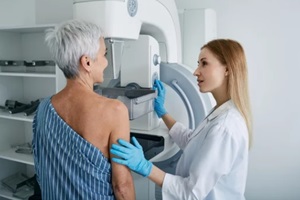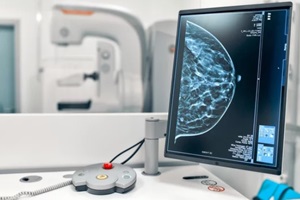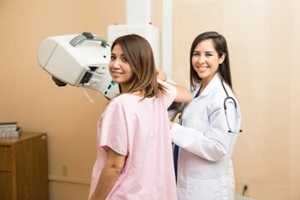 A mammogram is an important screening tool that uses low-dose X-rays to detect breast cancer early when it can be most easily treated.
A mammogram is an important screening tool that uses low-dose X-rays to detect breast cancer early when it can be most easily treated.
Knowing what to anticipate can help you feel more prepared and at ease when going for your first mammogram or annual screening.
What Happens During the Appointment
When you arrive at the imaging center, you’ll be asked to complete some paperwork about your health history, including any family history of breast cancer.
Be ready to provide details on the date of your last mammogram and where it was done, any breast biopsies or surgeries, and if you have breast implants.
Only you and a trained technologist will be in the exam room when it’s time for the mammogram. Here’s a quick look at what is likely to happen:
- You’ll be requested to remove your clothes from the waist up and put on a hospital gown.
- The tech will place your breasts one at a time onto the platform of the mammography machine. Your breast will be compressed between two plastic plates for a few seconds while the images are generated.
- The technologist compresses the breast tissue to spread it evenly and reduce radiation exposure. Although the compression can be uncomfortable, remind yourself that it lasts just seconds per image.
- Multiple images are generated of each of your breasts from varying angles. Take deep, relaxing breaths, and do your best to stay still until you’re done.
- Once the technologist confirms all images are complete, the appointment takes about 10 minutes. You’ll put your clothes back on and head out.
Tips to Make It More Comfortable
Here are some pointers to help make your mammogram experience as easy as possible:
- Schedule an appointment when your breasts are less sensitive, if possible. For most women, avoiding the week before your period is best.
- If you choose, take an over-the-counter (OTC) pain medication such as acetaminophen or ibuprofen an hour before the mammogram.
- Avoid wearing anything such as lotion, deodorant, or powder under your arms or on your breasts on the day of the test, as they can create artifacts on the images.
- Consider wearing pants and a top instead of a dress, so you only need to remove your shirt and bra.
- Take slow, relaxing breaths, and relax your muscles when your breasts are compressed. Tensing up often makes it feel worse.
- Let the technologist know if you’re having severe discomfort so they can shift the plates slightly.
What to Expect After Your Mammogram
After your mammogram, a doctor, known as a radiologist, will carefully examine all the X-ray images for any areas of concern. If you had a routine annual screening mammogram, it can take up to 2 weeks to receive your results. However, facilities aim to deliver results much sooner when possible.
If you don’t hear anything within 10 to 14 days after your screening mammogram, don’t assume that no news is good news. Call your doctor’s office to follow up. Here’s some guidance on the common mammogram outcomes you could receive:
Normal/Negative Results
 A normal (or negative) mammogram result means the radiologist did not identify any cancer or other breast abnormalities. Benign findings such as cysts or calcifications may appear, but they are not dangerous.
A normal (or negative) mammogram result means the radiologist did not identify any cancer or other breast abnormalities. Benign findings such as cysts or calcifications may appear, but they are not dangerous.
With normal results, you resume your annual mammogram screening based on the timeline recommended for your age and risk factors. Make sure your information is current at the imaging center you visit so you receive reminder notices when your next exam is due.
Inconclusive Results
Sometimes, the quality of mammogram images makes it hard for the radiologist to tell if an area needs further assessment. This may happen if your breasts are denser or you moved during the test. If your results are inconclusive, you’ll be contacted and asked to return for repeat images of the concerning region.
The repeat mammogram appointment focuses on getting clearer, more detailed pictures of the part of your breast tissue that needs additional evaluation. This localized, problem-focused imaging may suffice. But depending on what the extra mammogram views reveal, you might need an ultrasound or other imaging, too.
Abnormal Results
Abnormal results mean there is a region of breast tissue or calcifications that looks questionable and warrants a closer analysis. When this occurs, your mammogram report will state that you need “further diagnostic work-up” or “additional imaging.” If you receive a certified letter stating this, it understandably sparks anxiety.
The Most Common Next Steps After an Abnormal Mammogram Result
If your screening mammogram yields abnormal results, additional imaging or testing may be recommended to examine the area more closely. Don’t panic, though—many abnormalities are benign. Follow-up appointments allow specialists to determine whether concerning spots are problematic or harmless.
The most common next steps after an abnormal mammogram result include:
Diagnostic Mammogram
This special mammogram takes more pictures to precisely re-examine any regions causing concern about the screening mammogram. A doctor is present to make sure thorough images are taken of the area from multiple angles.
Breast Ultrasound
Soundwave technology checks suspicious spots for fluid-filled cysts versus solid masses. Ultrasound also assesses blood flow within abnormalities.
MRI Scan
Contrast dye is injected, and several X-ray images are generated as it flows through the breast tissue. This dynamic imaging lets radiologists assess abnormalities three-dimensionally. It also charts microcalcifications.
 Biopsy
Biopsy
Cells or tissue are extracted from abnormal areas of the breast with a hollow needle or incision so they can be analyzed under the microscope. This is the only way to confirm if cancerous cells are present. If cancer is discovered, your doctor will discuss how you should proceed.
Keep Your Breasts Healthy With Mammograms and Assistance From Raleigh Gynecology and Wellness
Staying on top of recommended breast cancer screening through annual mammograms is essential to keep yourself safe. Don’t let myths or anxiety over callbacks stop you from undergoing this potentially lifesaving exam.
Raleigh Gynecology and Wellness specialists offer thoughtful guidance each step of the way to reduce confusion and worry. Contact us today at (919) 636-6670 or online to discuss a mammogram schedule personalized to your risk profile and wellness priorities.
